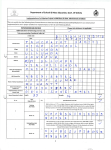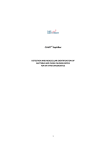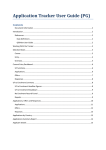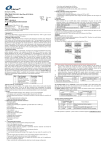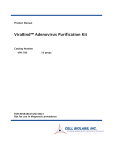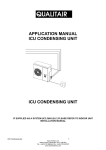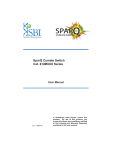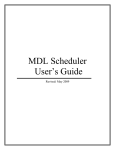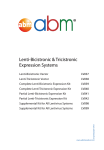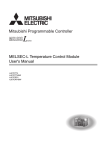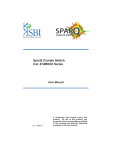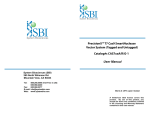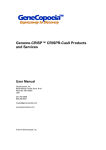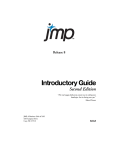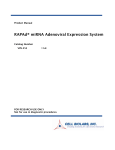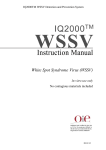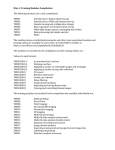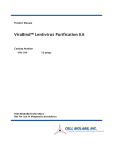Download Application Handbook - Applied Biological Materials
Transcript
iCumateTM Inducible Lentiviral Expression System Application Handbook WELCOME Notice to Purchasers 0 abm’s products are guaranteed to meet required quality control standards at the time of shipment. Notice of problematic products must be made within 10 days of receipt. This product warranty limits abm’s liability to the replacement of the product only. Technical Support Applied Biological Materials Inc. Tel: (8:30am - 4:30pm PST, Mon - Fri) Toll Free: (866) 757-2414 Local: (604) 247-2416 Fax: (604) 247-2414 (24 hours) Address : Suite #8-13520 Crestwood Place, Richmond, BC, Canada V6V 2G2 Website : http://www.abmGood.com Email : General: [email protected] Order: [email protected] Technical Support: [email protected] Business Development: [email protected] Intro Introduction 0 Inducible gene expression represents a fundamental technology that is irreplaceable to life sciences research. Consequently, a sustained effort towards improving the current technology has provided a wide range of systems, employing inducers such as heavymetals (8), steroid hormones (3), temperature (7), and antibiotics (i.e. tetracycline) for the manipulation of gene expression. While many of these gene expression systems have been able to cater to specific, individual requirements, leaky gene expression, risk of undesirable pleiotropic effects caused by the inducer along with the associated experimental cost all present a range of outstanding issues that often limit their application. Therefore, in a successful endeavor to address these underlying issues, abm has engineered the iCumateTM Inducible Lentiviral Expression System to effectively combine robust, yet easily tunable gene expression to meet the escalating, challenging demands for this core technology. abm’s iCumateTM Inducible Lentiviral Expression System utilizes a switchable interaction between the repressor (CymR), inducer (cumate) and operator (CuO) from the p-cym operon from Pseudomonas putida (2) that in turn regulates the strong CMV promoter. In the ‘OFF’ state, the repressor (CymR) binds with high affinity to the operator sequence (CuO) that is strategically placed downstream of the CMV promoter (a strong viral promoter that is active in most mammalian cells) (Figure 1, p.2). Once bound to CuO, CymR blocks transcription through the CMV promoter, thus abrogating any downstream gene expression. Association of the inducer (cumate) with CymR renders it incapable of binding to CuO, thereby enabling transcription to proceed unhindered (Figure 1, p.2). The employment of a finely titratable inducer such as cumate, coupled to the strong read-out from the CMV promoter constitutes the core design for all iCumateTM inducible vectors available from abm. An additional feature that makes abm’s iCumateTM Inducible Lentiviral Expression System highly desirable, is the non-toxic and cost effective nature of cumate as the inducer. Furthermore, induction with cumate does not lead to any significant background effect with respect to the host cells proteome expression profile. Lastly, unlike tetracycline that may exist in trace amounts in the fetal bovine serum (FBS) used for cell culture (thus causing leaky expression frequently associated with Tet-inducible systems), most FBS brands available on the market are completely free of cumate, making the iCumateTM Inducible Lentiviral Expression System the ideal choice for mediating non-leaky gene expression. iCumateTM Inducible Lentiviral Expression System 1 Intro Figure 1a. Cumate switch ‘ON’ 0 Cum Cum Cum CymR CMV CuO GOI 2A GFP GOI 2A GFP Figure 1b. Cumate switch ‘OFF’ CymR CMV CuO x Figure 1. A schematic representation of the cumate ‘switch’. 1a) The addition of cumate to the culture medium rapidly sequesters the bacterial repressor (CymR), preventing it from binding to the operator (CuO). This in turn enables transcription to proceed unhindered from the CMV promoter, inducing gene expression. 1b) Under cumate-free culture conditions, CymR binds to the operator sequence (CuO) placed downstream of the CMV promoter, therefore successfully and robustly blocking transcription. 2 iCumateTM Inducible Lentiviral Expression System CONTENTS Contents 0 1. Key Features . . . . . . . . . . . . . . . . . . . . . . . . . . . . . . . . . . . . . . . . . . . . . . . . . . . . 4 2. Components . . . . . . . . . . . . . . . . . . . . . . . . . . . . . . . . . . . . . . . . . . . . . . . . . . . . 5 3. Additional Materials Required. . . . . . . . . . . . . . . . . . . . . . . . . . . . . . . . . . . . 7 4. General Information on Lentivirus Technology . . . . . . . . . . . . . . . . . . . . . 8 5. Safety Guidelines . . . . . . . . . . . . . . . . . . . . . . . . . . . . . . . . . . . . . . . . . . . . . . . . 9 6. Infection Protocols. . . . . . . . . . . . . . . . . . . . . . . . . . . . . . . . . . . . . . . . . . . . . . 1 0 7. Troubleshooting. . . . . . . . . . . . . . . . . . . . . . . . . . . . . . . . . . . . . . . . . . . . . . . . . 1 1 8. The iCumate TM Technology. . . . . . . . . . . . . . . . . . . . . . . . . . . . . . . . . . . . . 12 9. References . . . . . . . . . . . . . . . . . . . . . . . . . . . . . . . . . . . . . . . . . . . . . . . . . . . . 1 3 iCumateTM Inducible Lentiviral Expression System 3 iCumateTM System 1. Key Features 1 With an aim to utilize the full potential of one of the most robust and costeffective gene expression systems on the market (based on the CMV promoter), abm has developed a comprehensive array of iCumateTM lentiviral vector kits and ready-to-use lentivirus particles for any human, mouse, and rat ORF, siRNA and miRNA for use with the iCumateTM expression system. Highlights of the iCumateTM Inducible Lentiviral Expression System include: • High transduction efficiency; based on a lentiviral vector format • High level of induced gene expression; based on the strong CMV promoter • Reliable, robust and finely titratable gene expression; particularly helpful for the expression of toxic proteins • Easy reversal of induction; ‘ON’ and ‘OFF’ switch • No basal/leaky gene expression • Availability of any human, mouse, or rat ORF, siRNA and miRNA lentiviral vector (see pages 6-8) • Flexibility of application, with All-in-One and dual vector formats Since cumate is non-toxic to cells, it permits greater dynamic ranges of induction, allowing you to select the level of gene expression to further extremes (see figure 2), either through the addition of more cumate or higher MOI of your virus. 0µg/ml 2.5 µg/ml 5 µg/ml 10 µg/ml 25 µg/ml 50 µg/ml Figure 2. The dose-dependent control of GFP gene expression by cumate. The experiment was conducted with a stable clone of 293CymR-CMV-CuO-GFP cells, cultured in the absence of cumate as well as increasing concentrations of 2.5 µg/ml, 5 µg/ml, 10 µg/ml, 25 µg/ml and 50 µg/ml cumate. Cells were cultured in the presence or absence of cumate for 48 hours before GFP positive cells were assayed. 4 iCumateTM Inducible Lentiviral Expression System iCumateTM System 2. Components 2 2.1 Dual Vector Format The dual vector format offers maximum flexibility with respect to the size of the insert, while ensuring the tightest regulation. This format provides the bacterial CymR repressor in one vector (Cat. No. iCu999 - figure 3a), with the gene of interest residing in a separate expression vector (for examples, see figures 3b and 3c). Similar to the All-in-One format, a drug selection marker and a reporter gene are also incorporated into the expression vector, all of which are available in a ready-to-use, viral particle format. Figure 3a) Cat. No. iCu999 Figure 3b) Cat No. iCu003 Figure 3c) Cat No. iCu007 Dual Vector Cat. No iCumate-pLenti-EF1a-CymR iCu999 + iCumate-pLenti-Cloning iCu001 iCumate-pLenti-Cloning-2A-GFP iCu003 iCumate-pLenti-Cloning-2A-RFP iCu005 iCumate-pLenti-Cloning-SV40-GFP iCu007 iCumate-pLenti-Cloning-SV40-RFP iCu009 iCumateTM Inducible Lentiviral Expression System 5 iCumateTM System 2.2 All-in-One Format 2 The All-in-One format has the advantage of convenience, however leaky expression may present challenges in achieving tight regulation of gene expression. In addition, the inclusion of the CymR repressor, a selection marker, a reporter and the desired insert within the same vector, limits the insert size to 2.5 kb (see figure 3d). The All-in-One format is provided as a single plasmid vector or ready-to-use viral particles. A selection marker and reporter gene are included to facilitate stable cell line generation and effectively monitor the induction efficiency. Figure 3d) Cat No. iCu013 All-in-One Vector Cat No. iCumate-pLenti-Cloning(All-in-One) iCu011 iCumate-pLenti-Cloning-IRES-GFP(All-in-One) iCu013 iCumate-pLenti-Cloning-IRES-RFP(All-in-One) iCu015 iCumate-pLenti-siRNA-Cloning-GFP(All-in-One) iCu017 iCumate-pLenti-miRNA-Cloning-GFP(All-in-One) iCu019 2.3 Ready-to-Use, pre-made iCumateTM Lentiviral Vectors The Ready-to-Use format provides you with iCumateTM inducible lentiviral vectors for any ORF, siRNA, or miRNA of human, mouse, and rat origin. Please visit our website www.abmGood.com/Lentivirus.html to determine the vector best suited to your needs prior to ordering. In addition, we will be more than happy to provide you with any custom-made vector you may require at an affordable cost and with the fastest turn-around time. 6 iCumateTM Inducible Lentiviral Expression System iCumateTM System 2.4 Control Vectors 3 A control should be included in all iCumateTM experiments. Our control vectors come available in a lentiviral vector format, with or without reporter gene expression to fulfil the requirements of any project. Please see the table below for a full listing of control vectors available : Control Vector Cat No. iCumate-pLenti-Blank iCu002 iCumate-pLenti-Blank-2A-GFP iCu004 iCumate-pLenti-Blank-2A-RFP iCu006 iCumate-pLenti-Blank-SV40-GFP iCu008 iCumate-pLenti-Blank-SV40-RFP iCu010 iCumate-pLenti-Blank(All-in-One) iCu012 iCumate-pLenti-Blank-IRES-GFP(All-in-One) iCu014 iCumate-pLenti-Blank-IRES-RFP(All-in-One) iCu016 iCumate-pLenti-scramble siRNA-GFP(All-in-One) iCu018 iCumate-pLenti-miRNA-Blank-GFP(All-in-One) iCu020 3. Additional Materials Required • • • • • • • • • • 2nd Generation Packaging System Mix (Cat. No. LV003) OR 3rd Generation Packaging System Mix (Cat. No. LV053) ProAdhere 293T Cell Line (Cat. No. LV592) Lentifectin™ Transfection Reagent (Cat. No. G074) Speedy Lentivirus Purification (Cat. No. LV999) qPCR Lentivirus Titration (Titer) Kit (Cat. No. LV900) ViralPlus Transduction Enhancer (Cat. No. G698) Cumate Solution (30mg/ml), 500ul (Cat. No. CH065) Polybrene (Cat. No. G062) FBS (Cat. No. TM999) Cell culture medium: PriGrow III (TM003) Protocols for the packaging of lentiviral particles can be found outlined in the following link: http://www.abmgood.com/His-Tag-Lentivirus-Expression-System.html iCumateTM Inducible Lentiviral Expression System 7 iCumateTM System 4 4. General Information on Lentivirus technology 4.1. Morphology Lentiviral particles consist of an envelope and nucleocapsid, a nucleoid and matrix proteins. The enveloped virions assume a spherical to pleomorphic shape of 80-100 nm in diameter with its surface covered in dense inconspicuous spikes approximately 8 nm in length. 4.2. Physical Properties Virions have a buoyant density of 1.13-1.18g/cm3 in sucrose. They are sensitive to treatment with heat, detergents, and formaldehyde; however, their infectivity is not affected by irradiation. 4.3. How a Lentivirus Works Once target cells are transduced with a recombinant lentivirus, the viral RNA is reverse-transcribed and actively imported into the nucleus (4) where it undergoes stable integration into the host genome (1). One to two days after the lentiviral genome is stably integrated into the host genome, you may begin to assay for the transient expression of your recombinant gene or use appropriate selection markers to generate a stable cell line for long-term, inducible gene expression studies. 4.4. VSV Glycoprotein Envelope Most commercial vectors of retroviral origin are limited in gene delivery applications because of their restricted tropisms and generally low titers. For recombinant lentiviral vectors, these limitations are resolved by pseudotyping the vector with the G glycoprotein gene from Vesicular Stomatitis Virus Glycoprotein (VSV-G) envelope. The significant advantages associated with the use of VSV-G envelope include: • Production of high titer lentiviral particles • Increased viral particle stability • Broader target cell ranges / tissue tropism • Highly efficient transduction efficiency (9). 8 iCumateTM Inducible Lentiviral Expression System iCumateTM System 5 4.5. Packaging Limits Recombinant lentiviral titers will decline with increasing insert size. The packaging limit for our lentiviral expression system is approximately 5.5 kb, above which, little to no virus will be produced. 5. Safety Guidelines abm’s iCumateTM Inducible Lentiviral Expression System employs third generation, self-inactivating, recombinant lentiviral vectors with minimal relation to the wild-type, Human HIV-1 Virus. The lentiviral particles produced with this system are replication-incompetent and designed with a number of safety features to enhance their bio-safety. All lentiviral expression systems provided by abm include the following safety features: • An enhancer deletion in the U3 region of 3’ΔLTR ensures self-inactivation of the lentiviral vector following transduction and integration into the target cell’s genomic DNA • Utilization of a RSV promoter upstream of 5’ΔLTR allows efficient Tetindependent production of viral RNA • The number of lentiviral genes necessary for packaging, replication and transduction are limited to three (Gag/Pol/Rev). All three genes are encoded by separate plasmids that in turn lack packaging signals. These plasmids share no homology to the expression vector and therefore prevent the generation of a recombinant virus with replicative potential. iCumateTM Inducible Lentiviral Expression System 9 iCumateTM System 6. Infection Protocols 6 iCumateTM inducible expression can be achieved by using either a one-step or a two-step lentiviral transduction method. Wherever possible, the two-step method is preferred for achieving optimal results (i.e. tighter regulation and higher levels of induced expression). The two-step transduction involves the initial generation of a CymR expressing (Cat. iCu999) stable cell line, followed by a second round of transduction with an inducible viral vector (see table on page 5) with a subsequent colony screening step. We have produced a 293-CymR stable cell line (Cat. T3016) which is also available for purchase; please see our website for more details. The one step method involves co-transduction of the CymR repressor virus (Cat. iCu999) and the cumate inducible virus (see table on page 5) at the same time. Alternatively, inducible gene expression can be achieved by the transduction of target cells with an All-in-One iCumateTM expression lentivirus (see table on page 6 for All-in-One vectors to suit your project needs). Note: In general, the one-step method is quick and relatively simple to execute. However, to achieve the best results (i.e. the tightest regulation and a high level of gene expression), the two-step procedure is recommended. For simplicity, the following protocol is given with the one-step protocol method, though either can apply. 1. Quantify virus titer. It is always useful to titer a viral preparation before proceeding with transduction, for the following reasons: • To ensure viability of the viral stock. • To determine the percentage of target cells that can be transduced with a pseudoviral stock. • To control the number of copies of viral constructs delivered per target cell. • To carefully determine the dosage of the selection marker by a standard killing curve assay. 2. On day one, plate target cells in a 24-well or 6-well plate at 30% density and incubate at 37°C with 5% CO2 overnight. 3. On day two, co-transduce target cells with the CymR repressor virus along with an inducible expression virus at a ratio of 1:1. A broad range of 10, 20, 10 iCumateTM Inducible Lentiviral Expression System iCumateTM System and 50 MOI for each virus in the presence of 0.8µg/ml polybrene and ViralPlus Transduction Enhancer (Cat. No. G698 - optional) should be tested to determine optimal results. Incubate cells at 37 °C with 5% CO2 overnight. An additional well should be set up for selection control purposes as previously described. 7 4. On day three (24 hours later), add the selection drug (Puromycin) at an appropriate dosage as determined by a killing curve plus cumate at 30µg/ml. Alternatively, add cumate after a stable cell line is generated if the inducible gene is toxic to the host cells. This is the critical step for successful clone selection in any stable cell line project. Please pay very detailed attention to the plating cell density, as this will determine the dosage of your selection drug. Ensure that the target cells are selected at the same density as those plated in your drug killing curve assay. It is highly recommended to have a selection control (non-tranduced cells - also at the same cell density) to monitor the selection process effectively, i.e. selection is complete when all cells in the control are dead. 5. Monitor the selection process by reporter gene expression. 6. Once selection is complete, a stable cell line can be established by performing a screen for clones or cell sorting with FACS. 7. Once a good, stable cell line is acheived, you will be able to perform experimental assays for inducible ORF expression or assay for specific gene knockdown following induced siRNA or miRNA expression. 8. The cumate induction can be turned OFF at any time. Simply remove and change the culture medium with fresh media excluding cumate. The induced expression will fade within 24-72 hours. 9. Similarly, the cumate induced expression can be turned back ON to test for repeated expression of your gene of interest. Simply add cumate back to the culture medium at any point to re-induce expression. 7. Troubleshooting 7.1. No or low reporter gene expression a. Confirm the virus titer by a titer assay to ensure the viability of your iCumateTM Inducible Lentiviral Expression System 11 iCumateTM System recombinant virus before transformation b. Increase virus MOI for higher transduction efficiency c. Optimize the ratio of the inducible expression and CymR repressor viruses. Use equal MOIs of both the expression and transactivator viruses, as excess CymR virus will result in the induction becoming weak or undetectable. 8 7.2. Cell Toxicity a. Ensure that polybrene is used at an optimal concentration b. Ensure that cumate is used at an optimal concentration c. If the induced gene is toxic to target cells, titrate the cumate to induce appropriate levels of target gene expression. 8. The iCumateTM Technology The iCumateTM technology is fully licensed from the National Research Council of Canada. The technology is covered by the following patents and patent applications. Purchase of the product does not grant any rights or license for use other than those explicitly listed in this Licensing and Warranty Statement. Use of the product for any use other than described explicitly herein may be covered by patents or subject to rights other than those mentioned. abm disclaims any and all responsibility for injury or damage, which may be caused by the failure of the buyer or any other person to use the product in accordance with the terms and conditions outlined herein. 12 Country Type Number Date Canada Application 2,446,110 5/1/2002 United States Patent 7,745,592 5/1/2002 United States Continution Application 12/769,048 5/1/2002 Belgium Patent 1385946 5/1/2002 Switzerland Patent 1385946 5/1/2002 Germany Patent 1385946 5/1/2002 France Patent 1385946 5/1/2002 Britain Patent 1385946 5/1/2002 Ireland Patent 1385946 5/1/2002 Italy Patent 1385946 5/1/2002 iCumateTM Inducible Lentiviral Expression System iCumateTM System 9. References 9 Further reading on the use of Lentiviral Vectors and methods for induced expression systems can be found here; 1. Buchschacher, G. L., Jr., and Wong-Staal, F. (2000) Development of Lentiviral Vectors for Gene Therapy for Human Diseases. Blood 95, 2499-2504 2. Eaton RW. (1997) p-Cymene catabolic pathway in Pseudomonas putida F1: Cloning and characterization of DNA encoding conversion of p-cymene to p-cumate. J Bacteriol, 179:3171-3180. 3. Klock G, Strahle U, Schutz G (1987) Oestrogen and glucocorticoid responsive elements are closely related but distinct. Nature (London), 329:734-736. 4. Lewis, P. F., and Emerman, M. (1994) Passage Through Mitosis is Required for Oncoretroviruses but not for the Human Immunodeficiency Virus. J. Virol. 68, 510-516 5. Mullick A, Xu Y, Warren Y, Koutroumanis Y, Guilbault C, Broussau S, Malenfant F, Bourget L, Lamoureux L, Lo L, Caron AW, Pilotte A and Massie B. (2006) The cumate gene-switch: a system for regulated expression in mammalian cells. BMC Biotechnology, 6:43 6. Naldini, L. (1999) in The Development of Human Gene Therapy (Friedmann, T., ed), pp. 47-60, Cold Spring Harbor Laboratory Press, Cold Spring Harbor, NY 7. Nouer L. (1991) Heat Shock Response. Boca Raton, FL: CRC. 8. Searle PF, Stuart GW, Palmiter RD (1985) Building a metal-responsive promoter with synthetic regulatory elements. Mol Cell Biol, 5:1480-1489. 9. Yee, J. K. (1999) in The Development of Human Gene Therapy (Friedmann, T., ed), pp. 21-45, Cold Spring Harbor Laboratory Press, Cold Spring Harbor, NY iCumateTM Inducible Lentiviral Expression System 13















